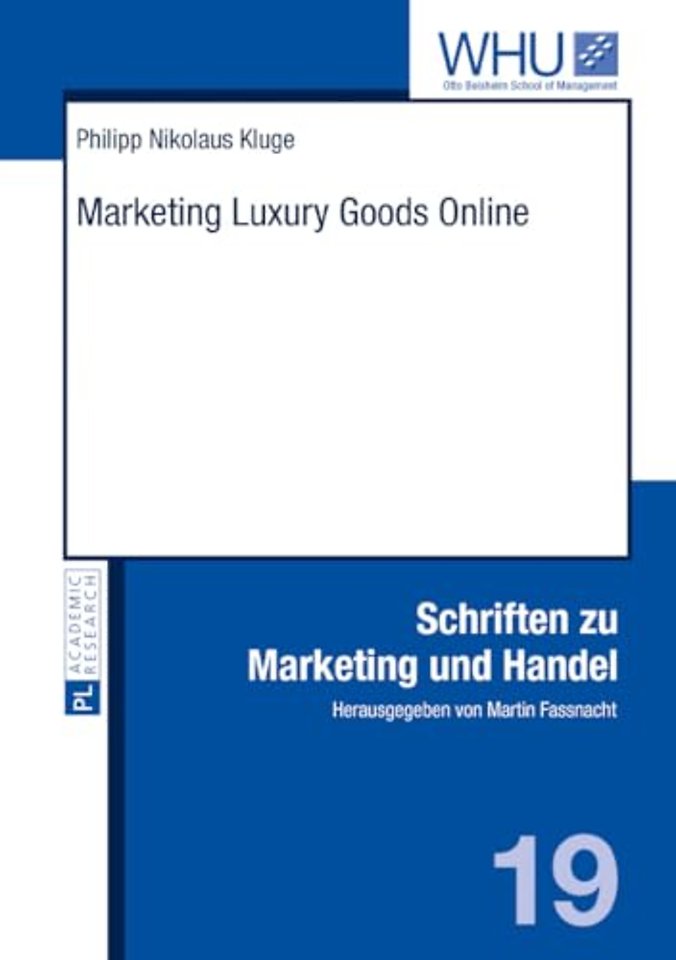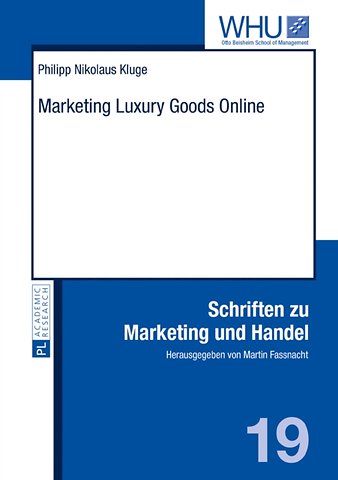Marketing Luxury Goods Online - 19
Samenvatting
The marketing of luxury goods faces a fundamental challenge: balancing sales growth against exclusiveness. In today's digital world, this trade-off has become even more challenging. A luxury brand's fragile concept of exclusiveness is seemingly incompatible with the ubiquitous availability provided by the mass medium Internet.
The author addresses this trade-off both conceptually and empirically. First, the author conceptually examines the specific marketing-mix for luxury goods in terms of product, price, communications, and distribution management. Second, this marketing-mix is applied to the online environment.
Third, the author empirically tests the effects of the online accessibility of luxury goods on consumer perceptions of scarcity and desirability.
Specificaties
Inhoudsopgave
Preface by Martin Fassnacht
Acknowledgements
Abbreviations
Symbols
1. Introduction
1.1 Motivation
1.2 Objectives of manuscript
1.3 Outline of manuscript
2. The Concept of Luxury
2.1 Constituent characteristics of luxury goods
2.1.1 Excellent quality
2.1.2 High-end price
2.1.3 Rarity
2.1.4 Aesthetics
2.1.5 Heritage
2.1.6 Superfluousness
2.2 Motives for buying luxury goods
2.2.1 Introduction
2.2.2 Perfectionist: highest quality
2.2.3 Hedonist: pleasure and self-reward
2.2.4 Veblenian: status
2.2.5 Snob: uniqueness
2.2.6 Bandwagon: affiliation
2.2.7 Gift-giving
3. Marketing-Mix of Luxury Goods
3.1 Product management of luxury goods
3.1.1 Introduction
3.1.2 Product strategy
3.1.2.1 Objectives
3.1.2.2 Strategic direction
3.1.2.3 Product-mix
3.1.3 Product design
3.1.3.1 Function
3.1.3.2 Aesthetics
3.1.3.3 Packaging
3.1.3.4 Add-on services
3.1.3.5 Branding
3.2 Pricing of luxury goods
3.2.1 Introduction
3.2.2 Strategy
3.2.3 Analysis
3.2.4 Decisions
3.2.5 Implementation
3.3 Communication of luxury goods
3.3.1 Introduction
3.3.2 Objectives
3.3.3 Audience
3.3.4 Message
3.3.5 Instruments
3.3.5.1 Advertising
3.3.5.2 Public relations
3.3.5.3 Events
3.3.5.4 Sponsoring
3.3.5.5 Direct marketing
3.3.5.6 Sales promotion
3.3.5.7 Integrated communication mix
3.3.6 Budget and monitoring
3.4 Distribution of luxury goods
3.4.1 Introduction
3.4.2 Distribution strategy
3.4.2.1 Objectives
3.4.2.2 Channel length: retail and wholesale distribution
3.4.2.3 Channel width: selective and exclusive distribution
3.4.3 Store-level decisions
3.4.3.1 Location
3.4.3.2 Store format
3.4.3.3 Store atmosphere
3.4.3.4 Merchandising
3.4.3.5 Service level
4. Online Marketing-Mix of Luxury Goods
4.1 The Internet and luxury
4.2 Online product management
4.2.1 Online suitability of luxury goods
4.2.2 Online product-mix
4.2.3 Online product display
4.2.4 Online add-on services
4.3 Online price management
4.3.1 Cross-channel price discrimination
4.3.2 Online price discounts
4.3.3 Online price communication
4.4 Online communication
4.4.1 Online communication and luxury
4.4.1.1 Benefits of online communication
4.4.1.2 Concerns about online communication
4.4.1.3 Conclusion: the online communication imperative
4.4.2 Online communication instruments
4.4.2.1 Website
4.4.2.2 Search engine marketing
4.4.2.3 Online advertising
4.4.2.4 Social media marketing (SMM)
4.5 Online distribution
4.5.1 Online distribution and luxury
4.5.1.1 Benefits of online distribution
4.5.1.2 Concerns about online distribution
4.5.1.3 Conclusion: the online distribution challenge
4.5.2 Online store formats
4.5.2.1 Monobrand online store
4.5.2.2 Multibrand online retailers
4.5.2.3 Multi-channel integration
5. Expert Interviews – Online Distribution
5.1 Method
5.2 Results
5.2.1 Attitudes towards online distribution
5.2.2 Preserving brand luxury online
5.3 Conclusion
6. Theory and Hypotheses – Effects of Online Accessibility
6.1 Introduction
6.2 Socio-economic theory
6.2.1 (Neo-) classical economic theory
6.2.2 Snobbism.
6.2.3 Veblenian theory
6.3 Social-psychological theory
6.3.1 Commodity theory
6.3.2 Uniqueness theory
6.3.3 Naïve economic theories
6.3.4 Reactance theory
6.4 Hypotheses development
6.4.1 Online accessibility, scarcity, and desirability
6.4.2 Online accessibility, transaction convenience, and willingness-to-buy
6.4.3 Conclusion
7. Experiment 1 – Online Accessibility
7.1 Method
7.1.1 Sample: 183 high-income individuals from Germany
7.1.2 Procedure: self-administered online survey
7.1.2.1 Scenario: website of high-end watch brand Vaupré
7.1.2.2 Manipulation: online accessibility
7.1.2.3 Measurement scales
7.1.2.4 Pre-testing
7.2 Results
7.2.1 Preliminary analyses
7.2.1.1 Manipulation check
7.2.1.2 Confirmatory factor analysis
7.2.2 Hypotheses testing
7.2.2.1 Structural equation modeling
7.2.2.2 Analysis of variance
7.3 Conclusion
8. Experiment 2 – Online Accessibility and Price Display
8.1 Method
8.1.1 Sample: 142 luxury insiders from USA
8.1.1.1 Procedure of qualification test
8.1.1.2 Qualification criteria
8.1.1.3 Results of qualification test
8.1.1.4 Final sample
8.1.2 Procedure: self-administered online survey
8.1.2.1 Scenario: website of high-end writing instruments brand Vaupré. 193
8.1.2.2 Manipulation: online accessibility and price display
8.1.2.3 Measurement scales
8.1.2.4 Pre-testing
8.2.1 Preliminary analyses
8.2.1.1 Manipulation check
8.2.1.2 Confirmatory factor analysis
8.2.2 Hypotheses testing
8.2.2.1 Structural equation modeling
8.2.2.2 Analysis of variance
8.3 Conclusion
9. Conclusion
9.1 Conceptual findings
9.1.1 Specificities of marketing luxury goods
9.1.2 Online marketing-mix for luxury goods
9.2 Empirical findings
9.3 Limitations and future research directions
9.4 Managerial implications
References
Appendix
Anderen die dit boek kochten, kochten ook
Net verschenen
Rubrieken
- aanbestedingsrecht
- aansprakelijkheids- en verzekeringsrecht
- accountancy
- algemeen juridisch
- arbeidsrecht
- bank- en effectenrecht
- bestuursrecht
- bouwrecht
- burgerlijk recht en procesrecht
- europees-internationaal recht
- fiscaal recht
- gezondheidsrecht
- insolventierecht
- intellectuele eigendom en ict-recht
- management
- mens en maatschappij
- milieu- en omgevingsrecht
- notarieel recht
- ondernemingsrecht
- pensioenrecht
- personen- en familierecht
- sociale zekerheidsrecht
- staatsrecht
- strafrecht en criminologie
- vastgoed- en huurrecht
- vreemdelingenrecht







